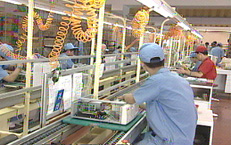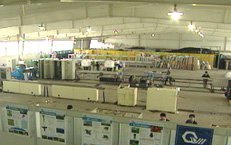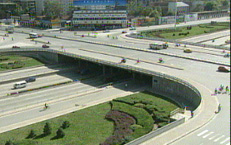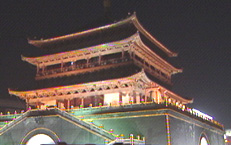 Visitors to Shaanxi will be privileged to see this amazing waist-drum dance. The harsh climate of the Yellow Earth Plateau has influenced the people of North Shaanxi to be optimistic and enthusiastic. Visitors to Shaanxi will be privileged to see this amazing waist-drum dance. The harsh climate of the Yellow Earth Plateau has influenced the people of North Shaanxi to be optimistic and enthusiastic.
Shaanxi is economically less developed. It has to solve problems of poor infrastructure, weak industrial structure and polluted ecological environment in order for the region to prosper.
 Shaanxi’s government recognizes the existing problems. According to the different features of south, central and north Shaanxi, the government is working out a series of measures to achieve change and development. South Shaanxi is emphasizing its mineral and water resources, while also building up its forestry. In the central Shaanxi plain they are focusing on Hi-Tech industries, technological equipment, irrigation systems, tourism and comprehensive agricultural production. The focuses of north Shaanxi are the development of natural resources, such as gas, coal and oil, and environmental protection. Shaanxi’s government recognizes the existing problems. According to the different features of south, central and north Shaanxi, the government is working out a series of measures to achieve change and development. South Shaanxi is emphasizing its mineral and water resources, while also building up its forestry. In the central Shaanxi plain they are focusing on Hi-Tech industries, technological equipment, irrigation systems, tourism and comprehensive agricultural production. The focuses of north Shaanxi are the development of natural resources, such as gas, coal and oil, and environmental protection.
 The province wants to establish a Central Shannxi Hi-Tech Industry Belt, including Xi’an, Baoji, Xianyang and Weinan Hi-Tech zones, and Yangling Agricultural Hi-Tech Demonstration Zone. The Xi’an Hi-Tech Industry Development Zone will lead this belt, as it is one of the 10 most successful zones in China and last year had a total industrial and trade revenue of 3.4 billion US dollars. Within all of these zones there are many new industries setting up, such as electronics, biological engineering and energy conservation projects. The province wants to establish a Central Shannxi Hi-Tech Industry Belt, including Xi’an, Baoji, Xianyang and Weinan Hi-Tech zones, and Yangling Agricultural Hi-Tech Demonstration Zone. The Xi’an Hi-Tech Industry Development Zone will lead this belt, as it is one of the 10 most successful zones in China and last year had a total industrial and trade revenue of 3.4 billion US dollars. Within all of these zones there are many new industries setting up, such as electronics, biological engineering and energy conservation projects.
The West China Development Project is an opportunity for every enterprise in the province. These companies are aiming to capture their target market and grow rapidly.
 Xi’an Seastar Science-Tech Enterprises Group is a private hi-tech enterprise that is registered in the Xi’an Zone. It was established in 1988, and has grown from a small scale research institute to a multi-national group with total assets of 375 million US dollars. The company is the only enterprise in the northwest region of China that has been listed as one of the top 10 private companies in China. Xi’an Seastar Science-Tech Enterprises Group is a private hi-tech enterprise that is registered in the Xi’an Zone. It was established in 1988, and has grown from a small scale research institute to a multi-national group with total assets of 375 million US dollars. The company is the only enterprise in the northwest region of China that has been listed as one of the top 10 private companies in China.
Compupacific International Xi’an, established in 1997, is another hi-tech enterprise in the city which is mainly engaged in the development and distribution of computer software.
 By the end of last year, there were 3,186 foreign enterprises, from more than 60 countries and regions, which had established companies in Shaanxi. The total foreign investment reached more than 3 billion US dollars. By the end of last year, there were 3,186 foreign enterprises, from more than 60 countries and regions, which had established companies in Shaanxi. The total foreign investment reached more than 3 billion US dollars.
While the science and technology industries in Shaanxi are extensive, the province was originally agriculturally based and 35 percent of the population still depend on farming. The issue of poverty is therefore still a major concern for the government with 69 poor counties.
 In 1997 the Chinese Government established the Yangling Agricultural Hi-Tech Industry Demonstration Zone. It aims to undertake research, introduce, develop and promote new agricultural techniques. In 1997 the Chinese Government established the Yangling Agricultural Hi-Tech Industry Demonstration Zone. It aims to undertake research, introduce, develop and promote new agricultural techniques.
The severe shortage of water resources has always been the biggest issue restricting the development of northwest China. The Yangling Qingchuan Water-Saving Company has a new irrigation system, which can reduce the amount of water used by up to 80 percent, and prevent soil erosion.
The Yangling Agricultural Zone are now selling their new variety of crops, the water saving irrigation system, the green pesticides, the medicinal products commercially. The availability of these new products is helping agriculture right across the north-west region of China.
The Yangling Zhongfu Bio-Engineering Company is producing high quality disease-free forestry trees and genetically modified seedlings. Demand has seen the company go into mass production of these plants.
The agricultural productivity of the northwestern region of China is closely linked to the strength and growth of the Yangling Agricultural Zone. The innovations coming out of the zone are helping farmers work more efficiently, therefore helping to bridge the economic gap between east and west China.
In Shaanxi there are many beautiful places, but people’s lasting impression is usually related to the incredible yellow soil. The locals are continually aware of the bare yellow earth. Every year 800 million tons of sand erodes into the Yellow River, removing the fertile topsoil, resulting in low-quality land and a hard life for the farmers.
The Chinese Government’s aim is to recreate a northwest region with “Green Mountains, Green waters, Blue Skies and Rich People.” They want to adjust the economic structure in the villages to eliminate poverty, and achieve sustainable development of both the economy and society.
 Shaanxi is in the ideal position to provide ecological protection for the upper and middle reaches of the Yellow and the Yangtze Rivers, but the natural environment in the province is already severely polluted. The total area with soil erosion problems is 107,500 square kilometres, with 70 percent of the population living in these areas. So Shaanxi is one of the main focuses of the environmental policies of the West China Development Project. Shaanxi is in the ideal position to provide ecological protection for the upper and middle reaches of the Yellow and the Yangtze Rivers, but the natural environment in the province is already severely polluted. The total area with soil erosion problems is 107,500 square kilometres, with 70 percent of the population living in these areas. So Shaanxi is one of the main focuses of the environmental policies of the West China Development Project.
The main environmental problems Shaanxi is tackling are reforestation of the hills, valleys and farmlands, and protection of the old-growth forests in Qinling and Bashan Mountain areas. The deterioration of the natural environment has had a direct effect on the local economy, the per capita income of Shaanxi’s farmers is less than 300 US dollars per year.
Zhifanggou water conservation zone, in Ansai, is a prime example of soil and water conservation agriculture. After 20 years working on the project, they are starting to see results, with the growth of many trees and the greening of the surrounding landscape.
At the current rate, the per capita income of this region, is doubling every five years. Shaanxi wants to improve the ecological environment by decreasing the amount of land effected by soil erosion. It will take a lot of time and effort to reverse the detrimental effects already evident in the natural environment.
In the past Shaanxi has been an important link for the trade between the east and west. The famous “Silk Road” starts in Xi’an city and runs all the way to Europe, where the Chinese originally traded exquisite Chinese crafts and goods. This route fostered a positive communication link between the east and west civilizations.
Shaanxi is a transportation and communication hub linking the northwest region to eastern China.
 To aid economic development in the region, the province has built up a transport network including, road, rail and air. Xi’an is the central point for 15 railways and 9 national roads. The government is investing a further 25 billion US dollars to increase the distance of the province’s roads to 3,000 kilometres. To aid economic development in the region, the province has built up a transport network including, road, rail and air. Xi’an is the central point for 15 railways and 9 national roads. The government is investing a further 25 billion US dollars to increase the distance of the province’s roads to 3,000 kilometres.
 Xi’an Xianyang Airport has the largest volume of air traffic in western China. It is already one of the four largest airports in the country, with over 3 million people passing through the airport each year. The expansion of the airport is now underway, and when completed, it will cost 170 million US dollars. Xi’an Xianyang Airport has the largest volume of air traffic in western China. It is already one of the four largest airports in the country, with over 3 million people passing through the airport each year. The expansion of the airport is now underway, and when completed, it will cost 170 million US dollars.
 Xi’an is the largest City in northwest China. The government hopes it will achieve considerable growth over the next few years. It will be the largest centre for finance trade, science and technology and information in northwest China. Xi’an and Shaanxi are rapidly changing, along with the whole of western China. Xi’an is the largest City in northwest China. The government hopes it will achieve considerable growth over the next few years. It will be the largest centre for finance trade, science and technology and information in northwest China. Xi’an and Shaanxi are rapidly changing, along with the whole of western China.
|









